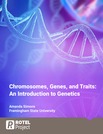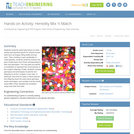
A gene as a stretch of DNA on a chromosome. Alleles as versions (sequence variants) of a gene.
- Subject:
- Biology
- Genetics
- Life Science
- Material Type:
- Lesson
- Provider:
- Khan Academy
- Provider Set:
- Khan Academy
- Author:
- Sal Khan
- Date Added:
- 12/10/2014

A gene as a stretch of DNA on a chromosome. Alleles as versions (sequence variants) of a gene.

This resource is intended for an introductory or intermediate-level college genetics course. It begins with an exploration of DNA and genome structure and continues with a study of the molecular mechanisms that drive gene expression. Concepts of classical transmission genetics are linked to the molecular mechanisms that underlie observable phenotypes. It concludes with specific topics that synthesize information from both molecular and transmission genetics, including consideration of topics like epigenetics, cancer biology, and evolution. Examples of both historical and current problems in genetics are presented, along with conversations of the relationship between genetics and society.

This course discusses the principles of genetics with application to the study of biological function at the level of molecules, cells, and multicellular organisms, including humans. The topics include: structure and function of genes, chromosomes and genomes, biological variation resulting from recombination, mutation, and selection, population genetics, use of genetic methods to analyze protein function, gene regulation and inherited disease.

This document contains eight genetic problems with multiple parts. These include crosses in which only one character are studied, crosses in which two characters are studied, crosses with multiple alleles, and crosses that are sex-linked.

Students randomly select jelly beans (or other candy) that represent genes for several human traits such as tongue-rolling ability and eye color. Then, working in pairs (preferably of mixed gender), students randomly choose new pairs of jelly beans from those corresponding to their own genotypes. The new pairs are placed on toothpicks to represent the chromosomes of the couple's offspring. Finally, students compare genotypes and phenotypes of parents and offspring for all the "couples" in the class. In particular, they look to see if there are cases where parents and offspring share the exact same genotype and/or phenotype, and consider how the results would differ if they repeated the simulation using more than four traits.

In a class discussion format, the teacher presents background information about basic human genetics. The number of chromosomes in both body cells and egg and sperm cells is covered, as well as the concept of dominant and recessive alleles. Students determine whether or not they possess the dominant allele for the tongue-rolling gene as an example.